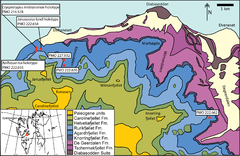| Tschermakfjellet Formation | |
|---|---|
| Stratigraphic range: Early Carnian ~ | |
 Geologic map with the formation in darker pink | |
| Type | Formation |
| Unit of | Kapp Toscana Group |
| Underlies | De Geerdalen Formation |
| Overlies | Sassendalen Group |
| Thickness | 63 metres (207 ft) at Tschermakfjellet |
| Lithology | |
| Primary | Sandstones and silty shales |
| Location | |
| Coordinates | 78°30′N 15°18′E / 78.5°N 15.3°E |
| Approximate paleocoordinates | 47°24′N 2°06′W / 47.4°N 2.1°W |
| Region | Svalbard |
| Country | |
| Type section | |
| Named for | Tschermakfjellet (type section from Botneheia) |
The Tschermakfjellet Formation is a geological formation in Svalbard, Norway, a subunit of the Kapp Toscana Group. The formation dates to the Late Triassic (early Carnian).
Description
It is named after the mountain of Tschermakfjellet in Dickson Land at Spitsbergen, while its type section is found at Botneheia in Nordenskiöld Land.[1][2] The formation has provided fossils of invertebrates and of an indeterminate pistosaurid.[3]
References
- ^ Harland 1997: p. 349
- ^ Buchan 1965: p. 26
- ^ Tschermakfjellet, Dickinsonland, Svalbard, early Carnian (Triassic of Svalbard and Jan Mayen) at Fossilworks.org
Bibliography
- Buchan, S.H.; Challinor, A.; Harland, W. Brian; Parker, J.R. (1965). The Triassic Stratigraphy of Svalbard. Oslo: Norsk Polarinstitutt.
- Harland, W. Brian (1997). The Geology of Svalbard. London: The Geological Society. ISBN 1-897799-93-4.
Further reading
- H. J. Campbell. 1994. The Triassic bivalves Daonella and Halobia in New Zealand, New Caledonia, and Svalbard. Institute of Geological and Nuclear Sciences Monograph 4:1-165

